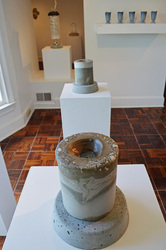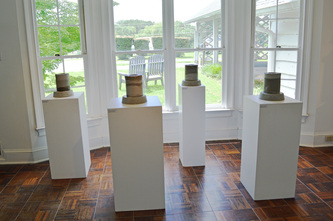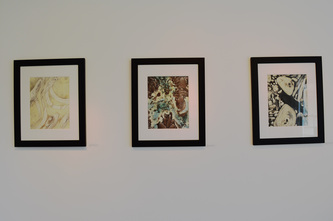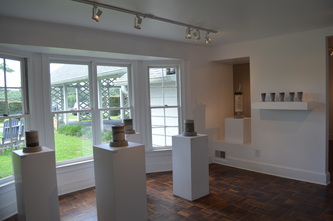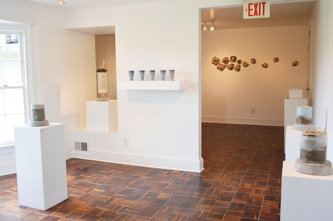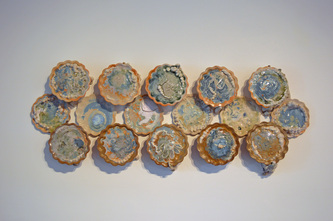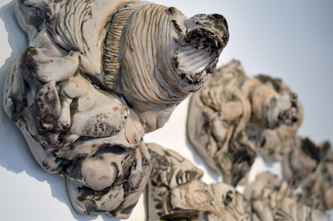Exhibitions & Installations
Becoming Undone.
A Solo Exhibition of Ceramic Sculpture by Rachael Marne Jones
Jessie Wilber Gallery at the Emerson Center for Art & Culture
May 9th- June 30th, 2026
Into The Thick of It (What you thought you saw, what you thought you knew). Porcelain, mason stains, plexiglass, Underglaze/glaze waste & Sink Sludge. "18x40x24.5". 2022.
Trace Remains
Rachael Marne Jones & Ryan Keith Parker
An Exhibition in conjunction with Extraction: Art on the Edge
at the Richard F. Brush Gallery August 27th-October 7th 2021
More here.
DEPTH OVER DISTANCE & THE SEED BANK PROJECT
A Solo Exhibition of Sculptural and socially engaged works
July 5th-July 30th, 2019
Lewistown Art Center, Lewistown Montana
Exhibition Statement
Depth Over Distance explores how objects (both man-made & organic) found within the landscape can influence our memory of, and subconscious connection to place. Through reiteration, and re-interpretation, these objects begin to evoke narratives of environmental subjugation, laden with both an anthropocentric, and geologic time. Folded into the geologic, the elemental materiality of bones, insulator fragments and refuse quietly tell a tale of our species adaptation to North America, while settling in to become indicators of rapid advance, expansion and significant environmental change.
The Seed Bank Project is an exploration of the inner-connectivity between cultures, ecologies, and the ever-elusive expanse of time. Each Bank ignites an active dialogue about the emotional intimacy of place through the in-situ burial of the vessels. The vessel's design amalgamates Indigenous Peoples of Mexico's seed saving practices, the ancient Egyptians use of beeswax in preservation, and modern technologies of the Earth Ship and the 1970's Sustainable Housing movements as well as ceramics' role within modern industry, fusing both ancient and contemporary technologies. The vessels are given to individuals around the world, who then choose seeds that have ecological and cultural significance to the area. The encapsulated seeds are then buried under the permafrost level. Families & organizations who plant the banks together will begin a multi-generational dialogue of the importance of ecological balance through an acknowledgement of imminent change observed in our environments. Hopefully the act of research and seed preservation encourages our species ability to adapt to change in a more sustainably intentional manner. The banks exist now, as we plant them while holding the potential to exist far into an unknown future: a future that depends on actions we take now to ensure a habitable place for generations to come. If you would like to see where banks have already been planted, or learn more about the project, please visit: www.rachaelmarnejones.com/sbp
Depth Over Distance explores how objects (both man-made & organic) found within the landscape can influence our memory of, and subconscious connection to place. Through reiteration, and re-interpretation, these objects begin to evoke narratives of environmental subjugation, laden with both an anthropocentric, and geologic time. Folded into the geologic, the elemental materiality of bones, insulator fragments and refuse quietly tell a tale of our species adaptation to North America, while settling in to become indicators of rapid advance, expansion and significant environmental change.
The Seed Bank Project is an exploration of the inner-connectivity between cultures, ecologies, and the ever-elusive expanse of time. Each Bank ignites an active dialogue about the emotional intimacy of place through the in-situ burial of the vessels. The vessel's design amalgamates Indigenous Peoples of Mexico's seed saving practices, the ancient Egyptians use of beeswax in preservation, and modern technologies of the Earth Ship and the 1970's Sustainable Housing movements as well as ceramics' role within modern industry, fusing both ancient and contemporary technologies. The vessels are given to individuals around the world, who then choose seeds that have ecological and cultural significance to the area. The encapsulated seeds are then buried under the permafrost level. Families & organizations who plant the banks together will begin a multi-generational dialogue of the importance of ecological balance through an acknowledgement of imminent change observed in our environments. Hopefully the act of research and seed preservation encourages our species ability to adapt to change in a more sustainably intentional manner. The banks exist now, as we plant them while holding the potential to exist far into an unknown future: a future that depends on actions we take now to ensure a habitable place for generations to come. If you would like to see where banks have already been planted, or learn more about the project, please visit: www.rachaelmarnejones.com/sbp
DEEP NOW & THE SEED BANK PROJECT
MFA Thesis Exhibition
April 2nd-6th, 2018
Exhibition Statement
“Deep Now & The Seed Bank Project was formulated with a rich recognition of cultural signifiers that relate how the 20th and 21st century has established Western Society’s values as well as a self-consciousness of our era. Through flow state drawing processes, artefactual sculpture and ritualistic, reliquarizing seed banks, the work hopes to deviate from apocalyptic visions, while recognizing an eminent paradigmatic shift in the future of Western Society. The exhibition harks to focus clearly on the clues from the past to rebuild a more interconnected and sustainable intention for our projection into space and time. Using both human-constructed forms within a geologic context, the sculptures of the Deep Now challenges how the industrial revolution has set a standard for linear time constructs, while the illustrations elude to a more intimately complex time/space continuum.
The Seed Bank Project is an exploration of the interconnectivity between specific cultures, ecologies, and the ever-elusive expanse of time. Each Seed Bank is meant to ignite a dialogue about the intimacy of place, our emotional connection to it, and to evoke a curiosity of the interconnectedness between us and the ecology of home, through a common burial ritual that transcends most cultures. The design of the seed banks wrap Indigenous Peoples of Mexico's seed saving practices, the ancient Egyptians use of beeswax as an excellent preservation material, and modern technologies of the Earth Ship and sustainable housing movements of the 70's, as well as the ceramic's role in modern industry all into one vessel. In and of themselves, they acknowledge both ancient and modern technologies. The banks also exist as an exploration of evolutionary time in the consideration of how innovations in technology have begun to condense our sense of time, specifically in relation to the construction of the 24-hour day and how the harnessing and storing of power has shifted our relationship with labor, materials and the manipulation of natural resources to perpetuate these innovations. The use of porcelain harks back to the very start of globalization, when Europe's competition to find the Arcanum for Asian porcelain defined the intellectual and material flood of global exchange.
Through ritual, families who plant the banks together will begin a multi-generational dialogue pertaining to the importance of ecological balance through an acknowledgement of future changes that we are beginning to see within the environment. Hopefully this ignites further discussions on our species ability to adapt to them in a more sustainable, and intentional manner. The banks exist now, as we plant them and also have the potential to exist far into an unknown future. What this future might look like depends on actions we take now to ensure a habitable place for generations to come.”
– Rachael Marne Jones
“Deep Now & The Seed Bank Project was formulated with a rich recognition of cultural signifiers that relate how the 20th and 21st century has established Western Society’s values as well as a self-consciousness of our era. Through flow state drawing processes, artefactual sculpture and ritualistic, reliquarizing seed banks, the work hopes to deviate from apocalyptic visions, while recognizing an eminent paradigmatic shift in the future of Western Society. The exhibition harks to focus clearly on the clues from the past to rebuild a more interconnected and sustainable intention for our projection into space and time. Using both human-constructed forms within a geologic context, the sculptures of the Deep Now challenges how the industrial revolution has set a standard for linear time constructs, while the illustrations elude to a more intimately complex time/space continuum.
The Seed Bank Project is an exploration of the interconnectivity between specific cultures, ecologies, and the ever-elusive expanse of time. Each Seed Bank is meant to ignite a dialogue about the intimacy of place, our emotional connection to it, and to evoke a curiosity of the interconnectedness between us and the ecology of home, through a common burial ritual that transcends most cultures. The design of the seed banks wrap Indigenous Peoples of Mexico's seed saving practices, the ancient Egyptians use of beeswax as an excellent preservation material, and modern technologies of the Earth Ship and sustainable housing movements of the 70's, as well as the ceramic's role in modern industry all into one vessel. In and of themselves, they acknowledge both ancient and modern technologies. The banks also exist as an exploration of evolutionary time in the consideration of how innovations in technology have begun to condense our sense of time, specifically in relation to the construction of the 24-hour day and how the harnessing and storing of power has shifted our relationship with labor, materials and the manipulation of natural resources to perpetuate these innovations. The use of porcelain harks back to the very start of globalization, when Europe's competition to find the Arcanum for Asian porcelain defined the intellectual and material flood of global exchange.
Through ritual, families who plant the banks together will begin a multi-generational dialogue pertaining to the importance of ecological balance through an acknowledgement of future changes that we are beginning to see within the environment. Hopefully this ignites further discussions on our species ability to adapt to them in a more sustainable, and intentional manner. The banks exist now, as we plant them and also have the potential to exist far into an unknown future. What this future might look like depends on actions we take now to ensure a habitable place for generations to come.”
– Rachael Marne Jones
Reflexive Morphology
at The Robert & Gennie DeWeese Gallery
January 19-March 2, 2018
Threshold
at the Waller Yoblonsky Gallery
February 28-March 3, 2017
Alternative Installation of Blár A' Chlachain
at the Waller Yoblonsky Gallery
December 16, 2016- December 19, 2016
at the Waller Yoblonsky Gallery
December 16, 2016- December 19, 2016
REFLECTION FOR BLÁR A' CHLACHAIN
My inspiration for this exhibition actually came to me (quite vividly) at a workshop that I was taking at the Anderson Ranch Center for the Arts in Aspen, Colorado. The workshop was designed around the instigation of creating ideas within your practice, to intertwine your artistic practice with your life practice. I am a somewhat spiritual person, not the most, not the least but meditation is important to me to keep me grounded. The idea of a space to contemplate inspired me, especially one to practice walking meditation (my favorite kind). The actual layout of the installation emerged from a drawing I did that was part of an exercise we did that consisted of doing 48 separate drawings in 48 minutes (1 drawing per minute). It is an excellent way to begin to allow your subconscious understanding of things emerge to your consciousness (another theme that runs throughout my work).
The actual content came to me later, from a separate (but related) experience. I decided to take a friend from Louisiana to Yellowstone in August (I know, I am insane haha) but she had never been and insisted on going despite my warnings of the crazy crowds, cars and noise pollution. As we were traversing the walkway, I couldn't help but think of the importance of protecting this ecology, but the walkway always left me with a visceral longing, I wanted to experience the hot pots and the landscape using all my senses. I then knew that I wanted to create a walkway made of porcelain (I love the versatility of clay and its ability to record touch and textures) that mimicked the textures that I saw, allowing the viewer to use the sensitive neurons in their feet to experience textures that were fabricated from the inspiration of the hot pots. The last third of the walkway was created from pouring liquified cornstarch into a vat and left to dry and crack. The smooth, pristine cornstarch balanced the rough textures of the worn walkway, and as the visitors walked through it, it began to record their footsteps through the degradation of that smooth surface (mimicking the ecological damage of visitors stepping off the walkway at the actual park). The piece on the back wall was really just a metaphor for the porcelain pots themselves, a decoy to get people on the walkway to walk closer to the piece. This summer, we had a record year of visitors breaking the park's rules in such a way that caused permanent damage to the features and wildlife, and I hope to have instilled a more heightened awareness of each human's footprint on an ecological fragile site. The piece was also meant to encourage inner contemplation, to allow the visitor to come to terms with potential dichotomies of emotion within their own lives. I never explicitly stated that the visitor had to stay on the walkway, and hoped to entice them to do so, but then they would have to reconcile this action with no reward (as the reward of getting off the walkway in Yellowstone would be a more visceral experience, but within this installation, the visceral experience was only provided within the boundary of the walkway: getting off the walkway just brought you back to the wood floored, white cube gallery) The installation itself was divided into four layers of experience: the first being outside the gallery, being the loud and bustling student union hallway, the second, once you entered through the gallery door you were in a quiet, white cube space that was divided into two halves, the half you were in acknowledged the "white cube-ness" of the gallery and on the walls in vinyl, all the instructions and information you needed was given to you in preparation of your traverse ( shoe rack to hold your shoes, a towel and bath to wash your feet afterwards, the ranger desk in case you had any questions.) The third being the actual traverse itself- turning your back on the first half of the gallery, leaving text, shoes and white cube behind to fully immerse yourself in your senses. The fourth layer of experience was the "decoy" piece on the back wall. Being the only thing on the wall, it adds a metaphorical layer to the understanding of the fragility of the porcelain pots, it stands as a photograph, fixed in time, a memory of what they are and were during my life time. I have talked to many people about the installation, and many have understood my intentions through their experiences with the piece, many have their own interpretations and some people had got little out of it. I know as an artist it is impossible to instigate your intentions to everyone, as each person is unique and brings their own understanding of life to each situation. I hoped to acknowledge this allowance through the affordance of the walkway. The title "Blár A' Chlachain" comes from my intense interest in nordic languages that have acute phrases for phenomena in landscape, and these langauges are falling out of popular use. I hope to revive these phrases and these cultural ways of knowing through a shared experience.
My inspiration for this exhibition actually came to me (quite vividly) at a workshop that I was taking at the Anderson Ranch Center for the Arts in Aspen, Colorado. The workshop was designed around the instigation of creating ideas within your practice, to intertwine your artistic practice with your life practice. I am a somewhat spiritual person, not the most, not the least but meditation is important to me to keep me grounded. The idea of a space to contemplate inspired me, especially one to practice walking meditation (my favorite kind). The actual layout of the installation emerged from a drawing I did that was part of an exercise we did that consisted of doing 48 separate drawings in 48 minutes (1 drawing per minute). It is an excellent way to begin to allow your subconscious understanding of things emerge to your consciousness (another theme that runs throughout my work).
The actual content came to me later, from a separate (but related) experience. I decided to take a friend from Louisiana to Yellowstone in August (I know, I am insane haha) but she had never been and insisted on going despite my warnings of the crazy crowds, cars and noise pollution. As we were traversing the walkway, I couldn't help but think of the importance of protecting this ecology, but the walkway always left me with a visceral longing, I wanted to experience the hot pots and the landscape using all my senses. I then knew that I wanted to create a walkway made of porcelain (I love the versatility of clay and its ability to record touch and textures) that mimicked the textures that I saw, allowing the viewer to use the sensitive neurons in their feet to experience textures that were fabricated from the inspiration of the hot pots. The last third of the walkway was created from pouring liquified cornstarch into a vat and left to dry and crack. The smooth, pristine cornstarch balanced the rough textures of the worn walkway, and as the visitors walked through it, it began to record their footsteps through the degradation of that smooth surface (mimicking the ecological damage of visitors stepping off the walkway at the actual park). The piece on the back wall was really just a metaphor for the porcelain pots themselves, a decoy to get people on the walkway to walk closer to the piece. This summer, we had a record year of visitors breaking the park's rules in such a way that caused permanent damage to the features and wildlife, and I hope to have instilled a more heightened awareness of each human's footprint on an ecological fragile site. The piece was also meant to encourage inner contemplation, to allow the visitor to come to terms with potential dichotomies of emotion within their own lives. I never explicitly stated that the visitor had to stay on the walkway, and hoped to entice them to do so, but then they would have to reconcile this action with no reward (as the reward of getting off the walkway in Yellowstone would be a more visceral experience, but within this installation, the visceral experience was only provided within the boundary of the walkway: getting off the walkway just brought you back to the wood floored, white cube gallery) The installation itself was divided into four layers of experience: the first being outside the gallery, being the loud and bustling student union hallway, the second, once you entered through the gallery door you were in a quiet, white cube space that was divided into two halves, the half you were in acknowledged the "white cube-ness" of the gallery and on the walls in vinyl, all the instructions and information you needed was given to you in preparation of your traverse ( shoe rack to hold your shoes, a towel and bath to wash your feet afterwards, the ranger desk in case you had any questions.) The third being the actual traverse itself- turning your back on the first half of the gallery, leaving text, shoes and white cube behind to fully immerse yourself in your senses. The fourth layer of experience was the "decoy" piece on the back wall. Being the only thing on the wall, it adds a metaphorical layer to the understanding of the fragility of the porcelain pots, it stands as a photograph, fixed in time, a memory of what they are and were during my life time. I have talked to many people about the installation, and many have understood my intentions through their experiences with the piece, many have their own interpretations and some people had got little out of it. I know as an artist it is impossible to instigate your intentions to everyone, as each person is unique and brings their own understanding of life to each situation. I hoped to acknowledge this allowance through the affordance of the walkway. The title "Blár A' Chlachain" comes from my intense interest in nordic languages that have acute phrases for phenomena in landscape, and these langauges are falling out of popular use. I hope to revive these phrases and these cultural ways of knowing through a shared experience.
Installation Shots of Blár A' Chlachain
at the Exit Gallery
October 31, 2016 - November 18, 2016
at the Exit Gallery
October 31, 2016 - November 18, 2016
Blàr a’ Chlachain is a Gaelic term that translates as ‘the plain of the stepping stones’. I borrowed this term from Robert McFarlane’s Landmarks, inspired by the Hebridean’s use of language to acutely describe the landscape of the western isles. Their use of language was an integral part of topographical navigation, but also intimately describe their experience and connection to their landscape. Having the correct terminology for landscape is an art that is slowly fading, and my work delves into reviving these words within a simple, shared experience, in hopes of igniting an awareness of affordance. Affordance is a term used within psychology and design as “the quality of an environment or object that allows an individual to perform an action on, to or with it.” This awareness can ignite a deeper understanding of a place through sensorial experience.
I chose to base this installation off of Yellowstone National Park, as it is a primary source of inspiration in my work. For ecological reasons, the walk way is an important tool to minimize damage to the dangerous and fragile features but has always left me with a sense of experiential longing. As the attendance of the park keeps rising, it is increasingly important to protect the site for future generations, but my desire to experience this landscape with all my senses instigated the creation of a fabricated walkway with textures that one might feel if they were able to explore the landscape freely. The nerve endings in your feet are hypersensitive, and thus the best way to journey through the installation is barefoot, allowing yourself to be vulnerable to your senses.
I chose to base this installation off of Yellowstone National Park, as it is a primary source of inspiration in my work. For ecological reasons, the walk way is an important tool to minimize damage to the dangerous and fragile features but has always left me with a sense of experiential longing. As the attendance of the park keeps rising, it is increasingly important to protect the site for future generations, but my desire to experience this landscape with all my senses instigated the creation of a fabricated walkway with textures that one might feel if they were able to explore the landscape freely. The nerve endings in your feet are hypersensitive, and thus the best way to journey through the installation is barefoot, allowing yourself to be vulnerable to your senses.
Micro/Macro
An solo Exhibition of Porcelain Drawings & Sculpture
by Rachael Marne Jones
At the Roswell Art Center West Gallery in Roswell, GA.
July 15th- August 23rd, 2013.
An solo Exhibition of Porcelain Drawings & Sculpture
by Rachael Marne Jones
At the Roswell Art Center West Gallery in Roswell, GA.
July 15th- August 23rd, 2013.
